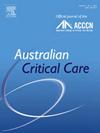Respiratory rate–oxygenation index and National Early Warning Score 2 score are associated with orotracheal intubation in patients with cardiogenic pulmonary oedema
IF 2.7
3区 医学
Q2 CRITICAL CARE MEDICINE
引用次数: 0
Abstract
Background
This study evaluates the association between the respiratory rate–oxygenation (ROX) index and the National Early Warning Score 2 (NEWS2) score with orotracheal intubation (OTI) and in-hospital mortality in patients with cardiogenic pulmonary oedema (CPE).
Methods
This retrospective observational study enrolled patients aged 18 years or older who had developed CPE at admission or during hospital stay. Demographic, clinical, and laboratory data were collected within the first 24 h of CPE onset from the electronic records. The outcomes needed for OTI during 24 h after CPE diagnosis and in-hospital mortality were also collected. The ROX index and NEWS2 were calculated using variables collected at CPE occurrence.
Results
Two hundred eighty-six patients with CPE were evaluated; however, 68 patients were excluded due to the absence of variables to calculate the ROX index. Thus, we included 218 patients in the analysis. The mean age was 67.8 ± 14.0 years, 51.8% were female, the median of the ROX index was 9.29 (6.06–13.05), and the median of the NEWS2 was 10.0 (7.0–12.0). Amongst these patients, 28.0% needed OTI 24 h after CPE and 30.3% died. In univariate analysis, lower values of the ROX index and higher values of the NEWS2 were associated with OTI. There was no association with mortality. In logistic regression models, the ROX index and NEWS2 were associated with OTI when adjusted by smoking, time of CPE, and endovenous nitrate and morphine (ROX index: odds ratio [OR] = 0.908, 95% confidence interval [CI] = 0.843–0.979, p = 0.012; NEWS2: OR = 1.261, 95% CI = 1.049–1.514, p = 0.013) and when adjusted by age, sex, and time of CPE (at admission or during hospital stay; ROX index: OR = 0.909, 95% CI = 0.847–0.976, p = 0.008; NEWS2: OR = 1.190, 95% CI = 1.015–1.396, p = 0.032).
Conclusions
The ROX index and NEWS2 were associated with OTI in CPE despite no association with mortality.
心源性肺水肿患者的呼吸速率-氧合指数和国家早期预警评分2评分与经气管插管相关
本研究评估心源性肺水肿(CPE)患者经口气管插管(OTI)时呼吸速率-氧合(ROX)指数和国家预警评分2 (NEWS2)评分与住院死亡率的关系。方法本回顾性观察性研究纳入了18岁及以上在入院或住院期间发生CPE的患者。从电子记录中收集CPE发病前24小时内的人口学、临床和实验室数据。还收集了CPE诊断后24小时内OTI所需的结果和住院死亡率。ROX指数和NEWS2使用CPE发生时收集的变量计算。结果共对286例CPE患者进行了评估;然而,由于缺乏计算ROX指数的变量,68例患者被排除在外。因此,我们将218例患者纳入分析。平均年龄67.8±14.0岁,女性占51.8%,ROX指数中位数为9.29 (6.06 ~ 13.05),NEWS2中位数为10.0(7.0 ~ 12.0)。其中28.0%的患者在CPE后24 h需要OTI, 30.3%的患者死亡。在单变量分析中,ROX指数越低,NEWS2越高与OTI相关。与死亡率没有关联。在logistic回归模型中,经吸烟、CPE时间、静脉内硝酸盐和吗啡校正后,ROX指数和NEWS2与OTI相关(ROX指数:优势比[OR] = 0.908, 95%可信区间[CI] = 0.843 ~ 0.979, p = 0.012;OR = 1.261, 95% CI = 1.049-1.514, p = 0.013),经年龄、性别和CPE发生时间(入院时或住院期间;火箭指数:或= 0.909,95% CI -0.976 = 0.847, p = 0.008;NEWS2:或= 1.190,95% CI -1.396 = 1.015, p = 0.032)。结论CPE患者ROX指数和NEWS2与OTI相关,但与死亡率无关。
本文章由计算机程序翻译,如有差异,请以英文原文为准。
求助全文
约1分钟内获得全文
求助全文
来源期刊

Australian Critical Care
NURSING-NURSING
CiteScore
4.90
自引率
9.10%
发文量
148
审稿时长
>12 weeks
期刊介绍:
Australian Critical Care is the official journal of the Australian College of Critical Care Nurses (ACCCN). It is a bi-monthly peer-reviewed journal, providing clinically relevant research, reviews and articles of interest to the critical care community. Australian Critical Care publishes peer-reviewed scholarly papers that report research findings, research-based reviews, discussion papers and commentaries which are of interest to an international readership of critical care practitioners, educators, administrators and researchers. Interprofessional articles are welcomed.
 求助内容:
求助内容: 应助结果提醒方式:
应助结果提醒方式:


